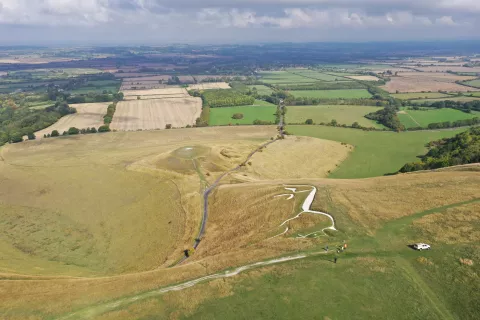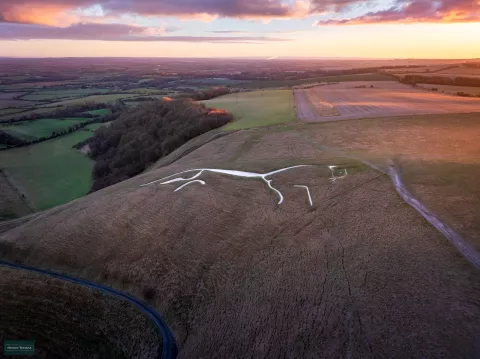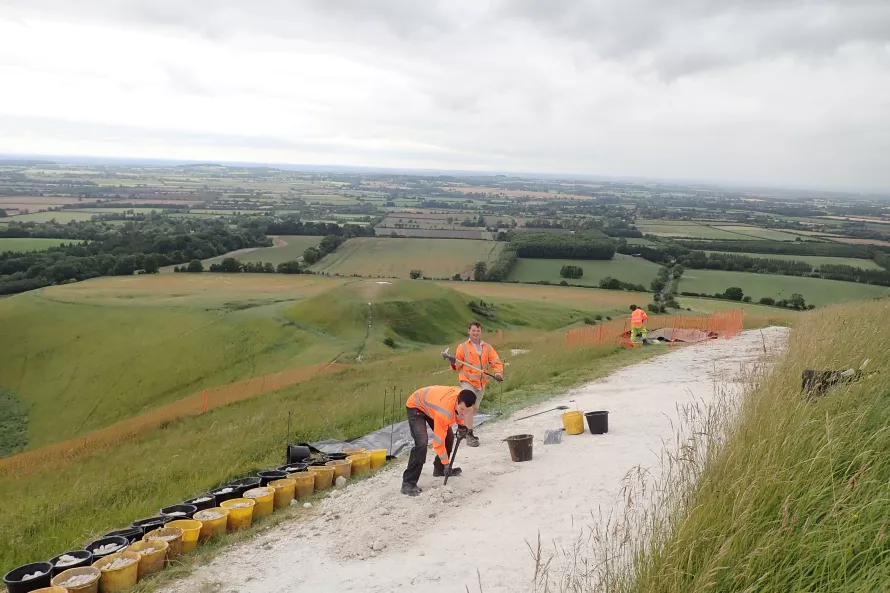Bill Bryson, the astute and amusing American commentator on things British wrote:
"Consider the White Horse of Uffington...it seems to me what is truly remarkable about the White Horse is, that continuously for around twenty centuries others have made the effort to maintain it. The White Horse has been preserved simply because people like it. I think that’s splendid."
The White Horse is a fragile creature. Gravity, and weather, worms, grazing animals and vegetation all work together to cover the figure with silt and encroaching turf. If left alone the White Horse would probably disappear in about a decade. We now know that the figure was made by cutting a trench into the ground. So if it was buried archaeologists could, in theory, resurrect it. But we have only had these excavation skills for about a century.
We know that since the 18th century people came together, every few years (but not with great regularity) to clean and scour the Horse, and hold the ‘Saxon Olympicks’. When, how and why earlier scouring happened is less certain.
In the early Bronze Age human beings across Europe and Asia were obsessed with horses and the sky. Horses transformed society, generating warrior elites. In mythology horses drew the sun across the sky in daytime, and returned at dawn. In this context the Horse was carved on the hillside, marking what had been a sacred landscape for centuries.
Yet in the following centuries new people arrived, religions and languages changed. Settlements were abandoned and shifted around the landscape. New elites speaking Celtic, Latin, Early English and Norman French arrived, and took control of the estates. Generations of peasants continued to farm the land, aware of the investment made by their ancestors. It is remarkable that they did not neglect the Horse figure, prominent on the hillside.

We know that when Britannia was under Roman control (AD 43– 450) the hill remained sacred; during this period, people were buried here. Horses also remained sacred – the horse goddess was Epona, particularly honoured in Gaul, and Gauls came to the region, in the army, as landowners and potters. At the same time there was a rider-god, a Saint George figure slaying the dragon of evil. So perhaps the mythology of the horse changed: old icons told new stories. Pagan Saxons adopted the ancient burial mounds and spread the stories of Weland and Tell across the living landscape. In the Medieval period, St George migrated from the Middle East to White Horse Hill, but his story may have been much older. And did the dragon maybe once guard treasure in Dragon Hill?
A horse remarkably like ours, along with a dragon, decorates the tenor bell of the Abbey Church of St Peter and St Paul, Dorchester-on-Thames. The bell was cast in Wokingham in the 14th century and, if it does indeed represent "our" White Horse, it may be the earliest known image. If so, it indicates that our flexible friend had once again insinuated itself into new stories and justified its continuing existence.
By the 17th century the English landed gentry were avid consumers of antiquity. Maps proliferated as the landowner was urged to ‘know his own’. John Speed’s small map of Berkshire (1627) marks the Hill and the Vale of the White Horse, while the huge Sheldon tapestry map of Oxfordshire contains an image of the Horse itself.

Following the Dissolution of the Monasteries and the distribution of monastic land by Henry VIII in the 1530s, Uffington’s land was taken from Abingdon Abbey (1537-8) and re-distributed to private owners. In 1620 the Jones family sold it to Elizabeth Craven, whose family retained it until the 1950s. The Cravens organised, or at least allowed, successive scourings. Visitors increased, encouraged by Celia Fiennes (1662 – 1741) to promote "its Glory and Esteem in our minds and cure the evil itch of over-valuing foreign parts". She should be the patron saint of the Visit England!
In the 17th-19th centuries the Uffington White Horse became an English icon – an over-used word, but accurate in this case. However, by the end of the century it slithered into neglect. In 1826 the celebrated travel writer known as the London Hermit described a King Alfred tourist trail, starting at a pub in Wantage – supposedly Alfred’s birthplace. At the time, English heritage prioritized patriotism and Christianity, so Alfred’s White Horse - as it was thought of at the time- topped the list of tourist attractions, above the pagan Stonehenge, for whom it was much harder to find a Christian interpretation.
Although rooted in the cultural and political agenda of the 19th century, this revival of the White Horse guaranteed its survival into our time.

